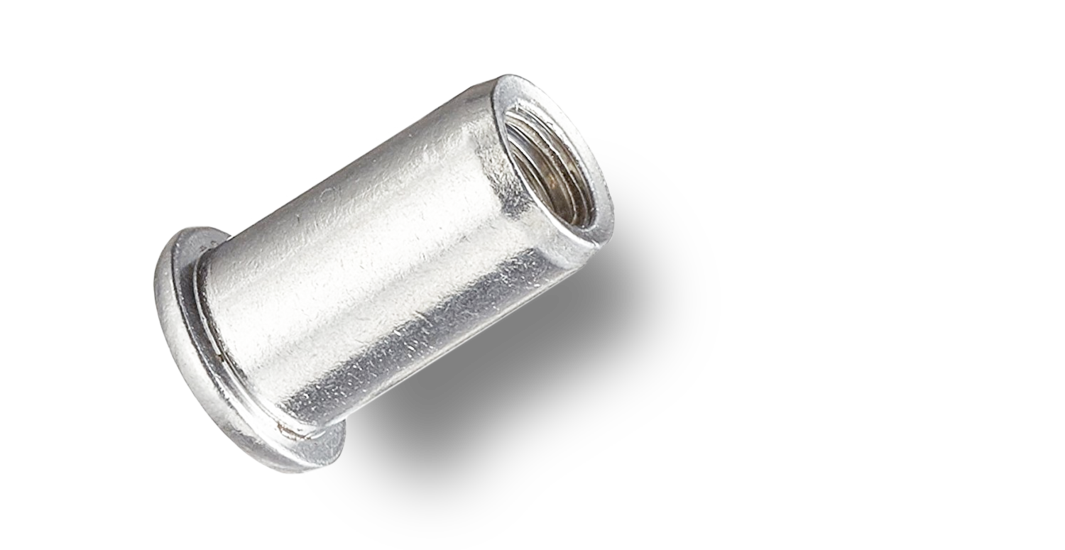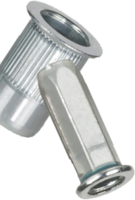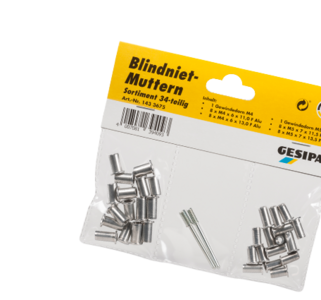Blind rivet nuts


Buy blind rivet nuts easily and
quickly
In the following blind rivet nuts categories, you can easily buy your desired rivet nuts online from one of our selected specialist dealers.

Blind rivet nuts and blind rivet studs are used across many diverse areas of trade and industry – with applications requiring a strong, non-permanent connection. The most common sectors include the automotive, white goods, heating and air conditioning, solar fixings, electronics and construction industries. Custom solutions are also developed and produced at the GESIPA® centre of excellence in Keighley, England in close collaboration with our technicians based in Germany.
Get in touch!
Have any questions regarding rivet nuts? Please don't hesitate to get in touch with a member of our team!
What is a blind rivet nut?
In principle, a blind rivet nut is a hollow threaded rivet. It can be inserted into a workpiece blind, i.e. with access from one side only. It is precisely this simplicity that makes the blind rivet nut so smart. GESIPA® blind rivet nuts are fasteners that can be used to create a heavy-duty thread for a detachable connection, especially on thin workpieces that can only be accessed from one side. Setting blind rivet nuts is often the only solution for creating a thread on thin or soft components with hollow profiles and components that are accessible from one side only. A thread can be attached in just a few simple steps. Fast, safe and reliable. GESIPA® blind rivet nuts and riveting tools
are optimally matched to each other. GESIPA® riveting tools are characterised by minimal wear, short processing times and a long service life, thus helping to optimise costs. Thanks to the in-house production of Fasteners in the GESIPA® competence centres, customer-specific requirements can be implemented economically and efficiently. Blind rivet nuts, for example, are used in a wide range of industrial and trade applications wherever a strong and detachable connection is required, for example in the automotive, white goods, electronics, food, solar or heating and air conditioning industries.
How is a blind rivet nut constructed?
The setting head is the part of the blind rivet nut that rests on the visible side of the component. The user can choose between the following variants: A blind rivet nut with a flat head ensures a large contact surface on the component. For a minimised protrusion of the blind rivet nut and thus an almost flat support of the assembly part, you should use a small-head blind rivet nut. Last but not least, there are blind rivet nuts with a countersunk head, which are suitable for flat surfaces with countersunk holes.
The shank is the part of the blind rivet nut that deforms during the setting process and fixes the blind rivet nut in the component. This creates the so-called closing head. The user can choose from the following shank variants: A round shank, the knurled shank or a polygonal shank (hexagonal or square).
The customer chooses the material himself: The blind rivet nut is available in steel, aluminium or stainless steel to suit the application.
How is a rivet nut processed?
Blind rivet nuts can be used to create load-bearing threads in thin materials without the use of a thread cutter. A hole at least 0.1 mm larger than the diameter of the blind rivet nut must be present in the workpiece that is to be riveted with the rivet nut. The blind rivet nut can then be twisted onto the threaded mandrels of the corresponding setting tool. The blind rivet nut is inserted into the drilled hole from one side. The length depends on the thickness of the material. Whether using manual pliers or an automatically operated rivet gun, the blind rivet nut deforms and adapts to the material to be riveted. The threaded mandrels can now be drilled out. The GESIPA® blind rivet nut is ready to join further workpieces to the material.
Advantages at a glance
- Quick and easy assembly with one-sided component accessibility
- Placement of high-quality threads in thin and soft materials (steel, aluminium, magnesium, plastics, etc.)
- No thermal influences on the components and therefore no heat distortion or damage to the surfaces of the components
- No reworking required
- Very high flexibility of the production process
- Low investment in assembly equipment
- Versatile use - also for hybrid Fasteners and soft materials
- Creation of watertight and gas-tight Fasteners
- No emission of heat, fumes and welding gases to the environment, and therefore no impairment (hazard) to people or the environment

Find & buy the right blind rivet nut now!
Order directly online - A large selection of different dimensions and material combinations are available from our specialist dealers.

Further questions about the blind rivet nut?
We provide answers to open questions below.
It should be noted that the blind rivet nut was developed to remain permanently in the workpiece after installation. If necessary, a set blind rivet nut can be removed from the workpiece using a suitable tool. However, there is a risk of damaging the workpiece, so particular care should be taken when working with this tool. Removal should be carried out by specialised personnel and with great care, especially if the workpiece is crucial for functionality. It should also be noted that a removed rivet nut cannot be reused. If a blind rivet nut is to be fitted again in the same place, a new one must be used.
The blind rivet nut is used in a wide variety of areas and industries. One well-known industrial sector in which rivet nuts are frequently used is the automotive industry. The blind rivet nut is used here, for example, to securely fasten dashboards, panelling or other parts. In the electronics industry, rivet nuts are used to fasten circuit boards, housings or other components. Blind rivet nuts are also used in the manufacture of machines and assemblies to connect several components together. This facilitates the assembly and disassembly of parts without damaging the threads. Other areas in which blind rivet nuts are generally used include the construction industry, e.g. in panelling, in furniture production and in the aerospace industry. There are many other areas of application for the blind rivet nut and the special thing is that there is a suitable rivet nut for every application.
In principle, a blind rivet nut is a hollow threaded rivet. It can be set blind, i.e. with access from only one side, into a workpiece. It is precisely this simplicity that makes the blind rivet nut so smart. GESIPA® blind rivet nuts are fasteners that can be used to create a heavy-duty thread for a detachable connection, especially on thin workpieces that can only be accessed from one side. Setting blind rivet nuts is often the only solution for creating a thread on thin or soft components with hollow profiles and components that are accessible from one side only. A thread can be attached in just a few simple steps. Fast, safe and reliable.
Thanks to the in-house production of Fasteners in the GESIPA® competence centres, customer-specific requirements can be implemented economically and efficiently. Blind rivet nuts are used, for example, in a wide range of industrial and trade applications, wherever a strong and detachable connection is required, for example in the automotive, white goods, electronics, food, solar or heating and air conditioning industries.
Further products from the field of blind rivet nut technology
Suitable riveting tools and blind rivet nuts for every application
